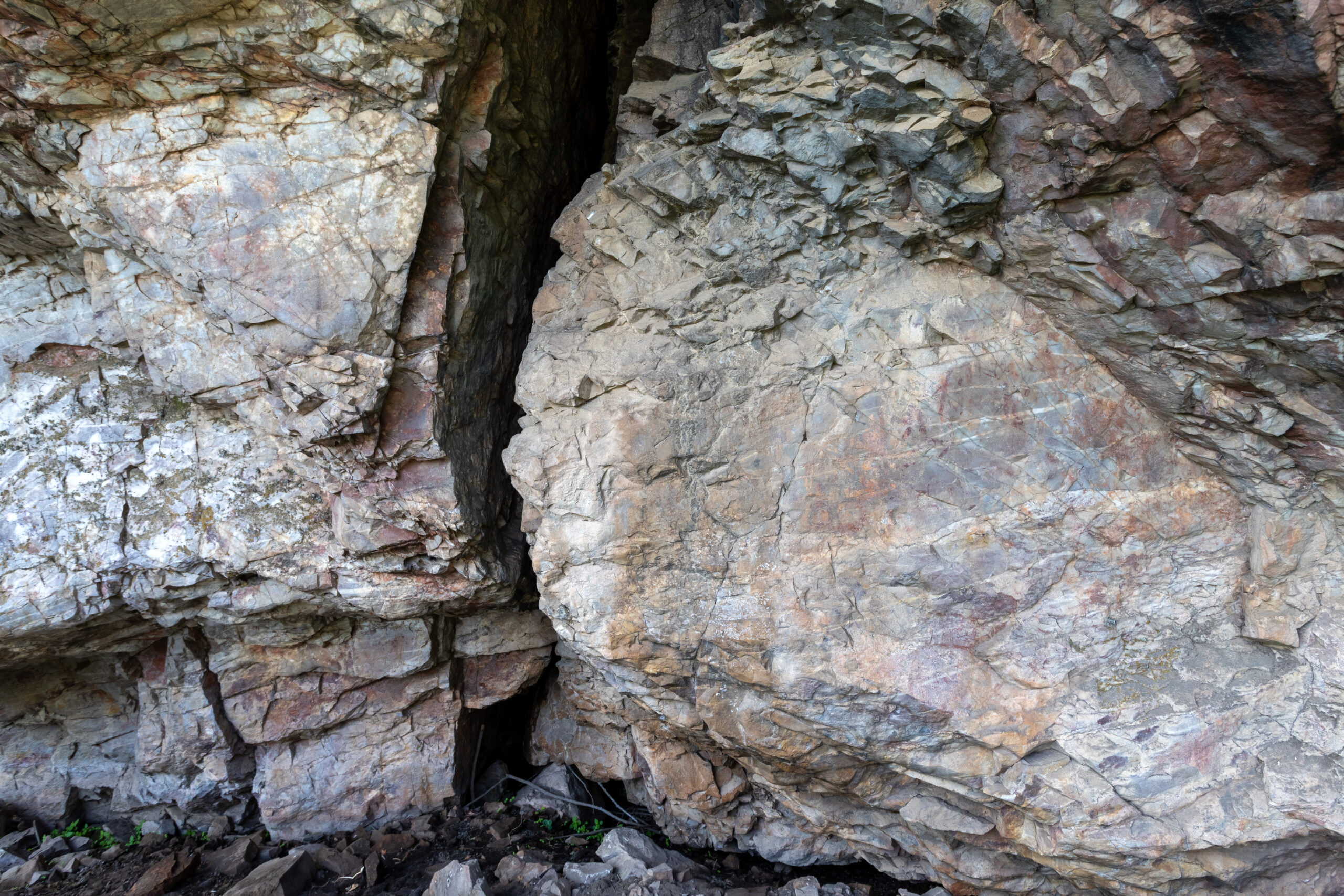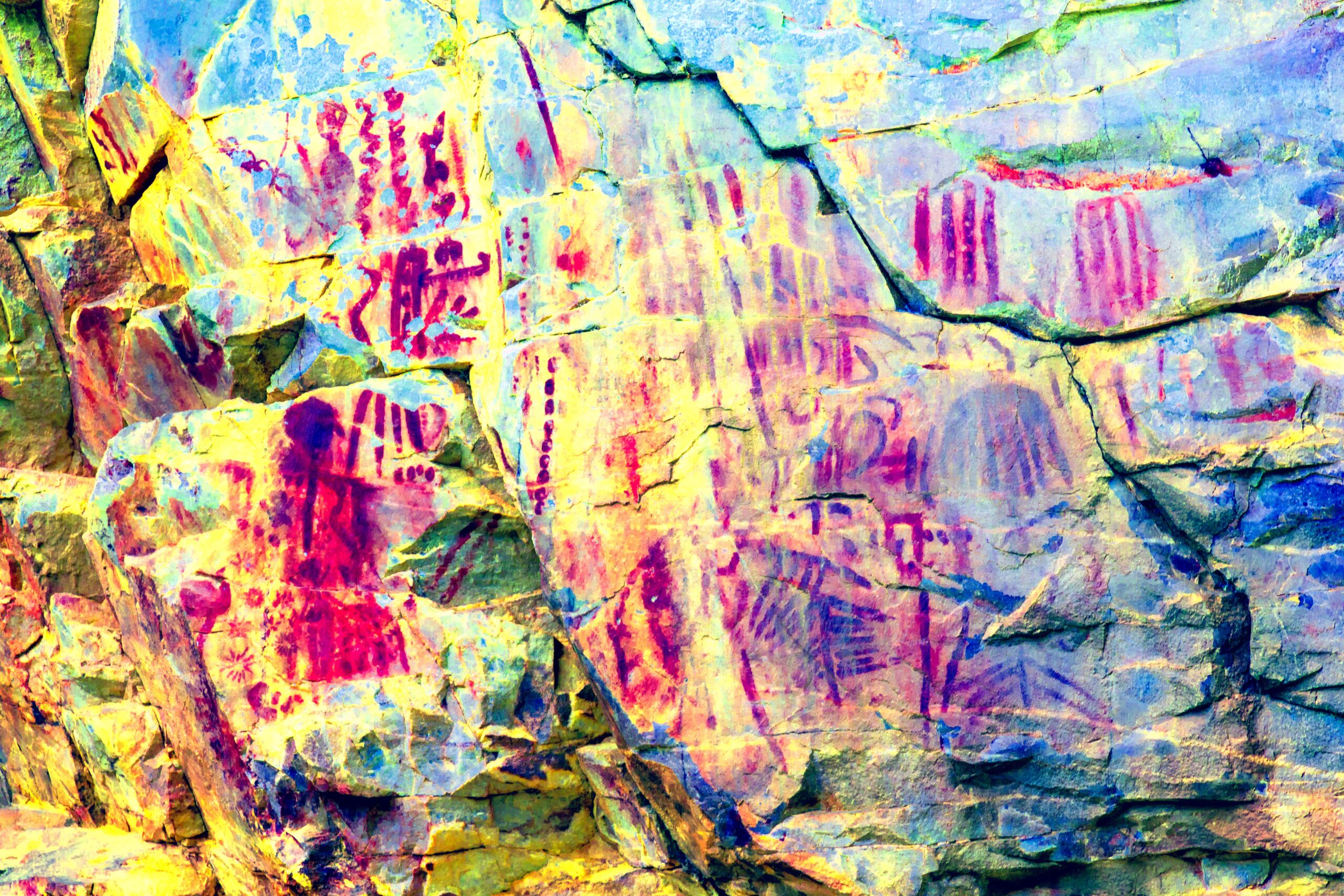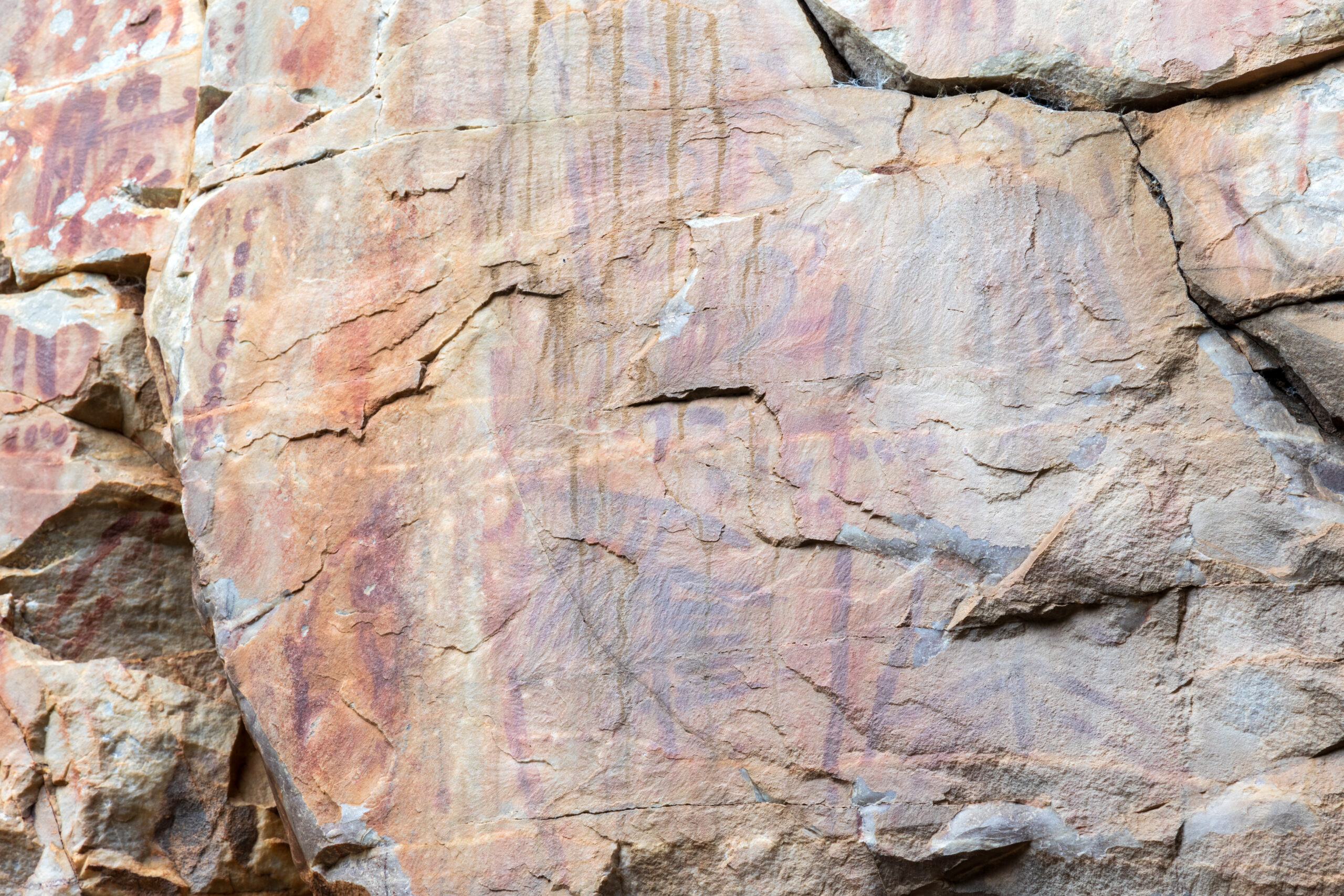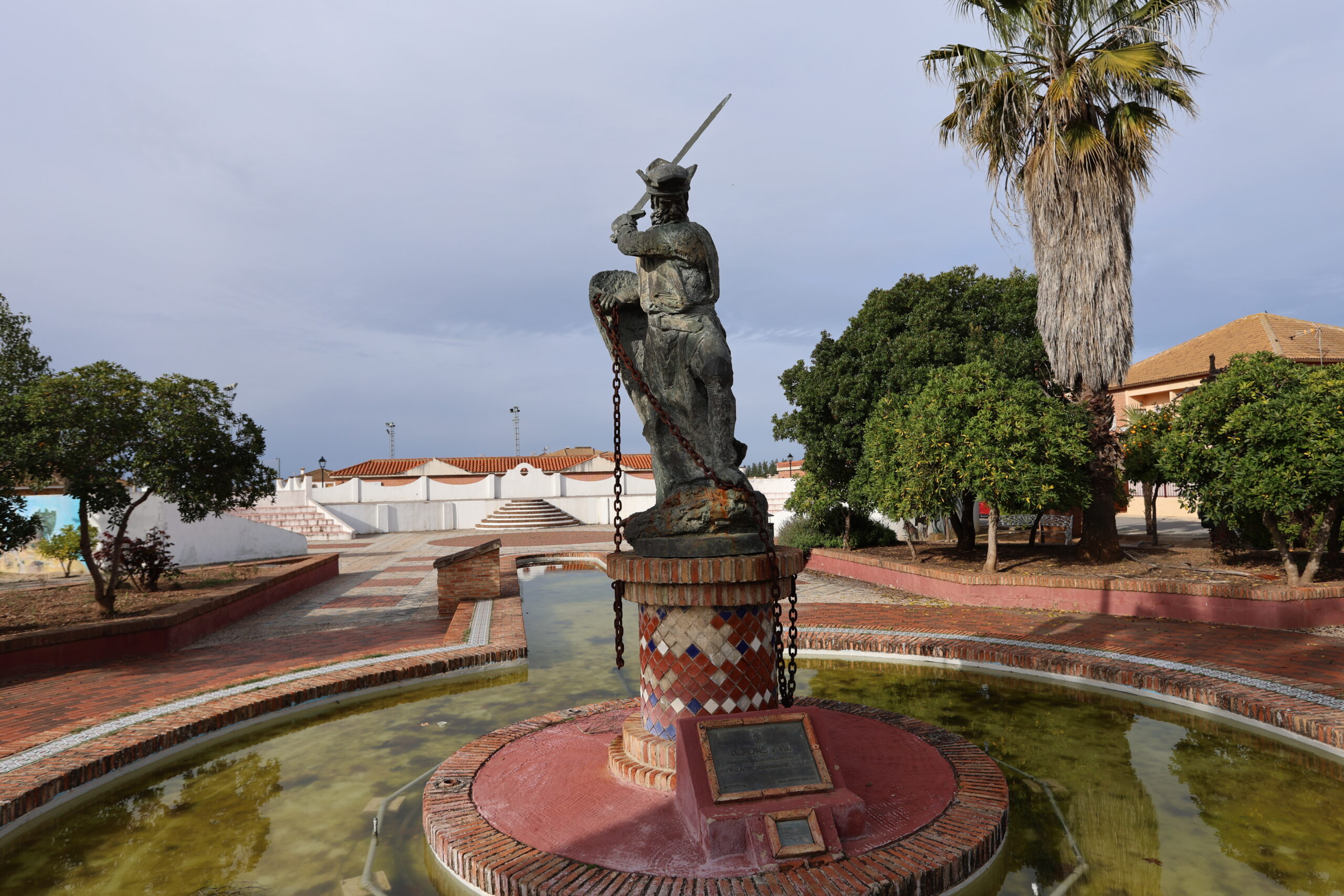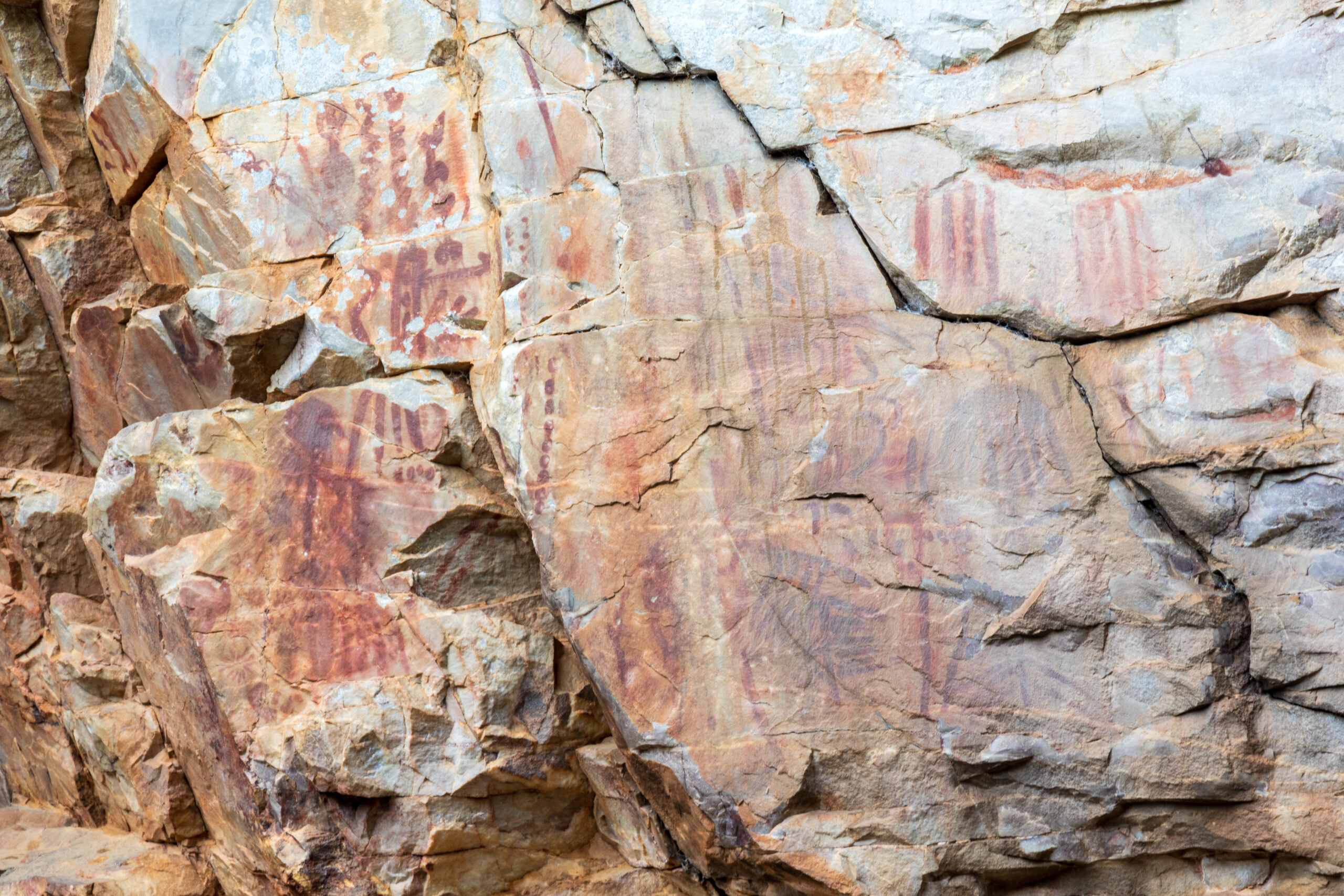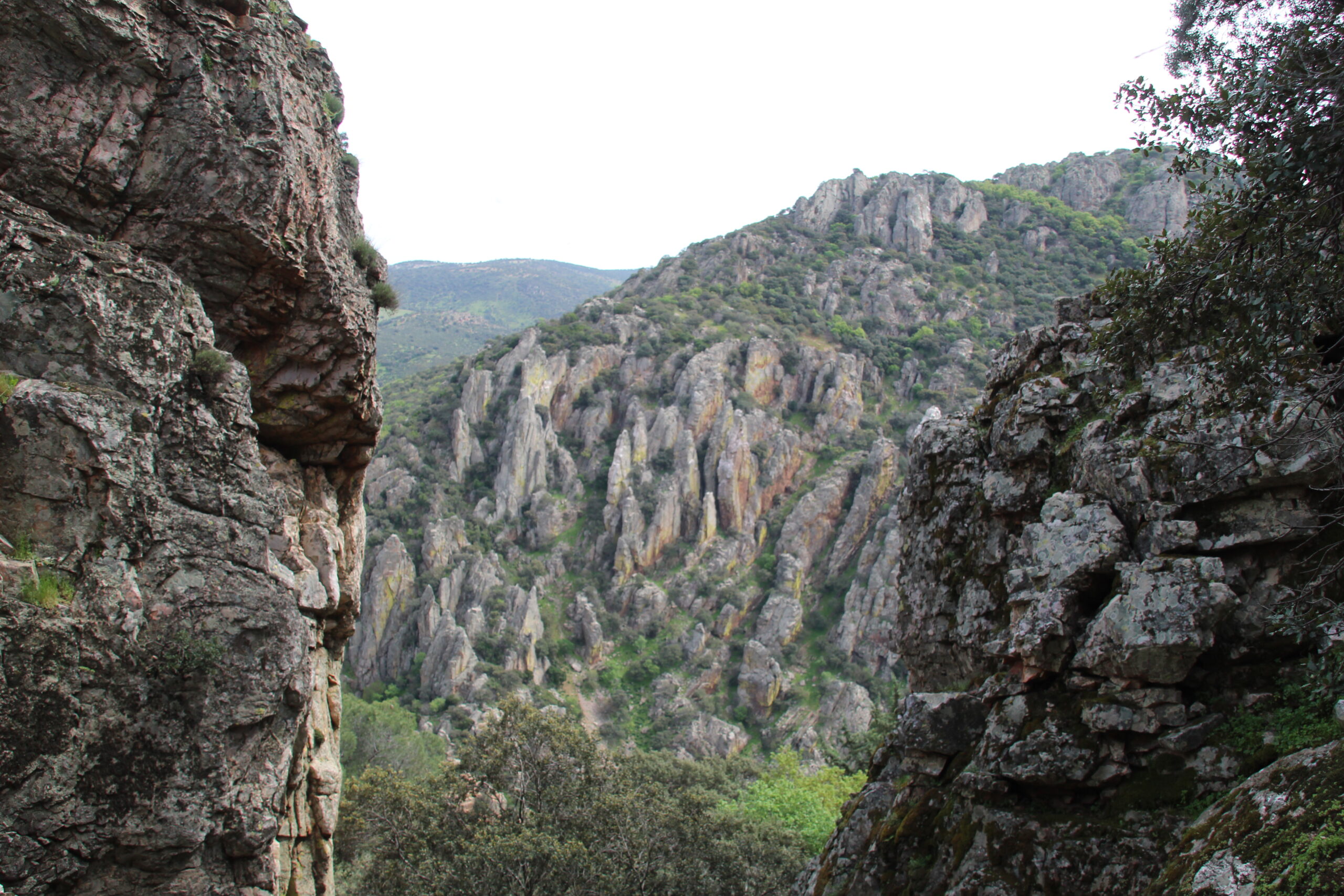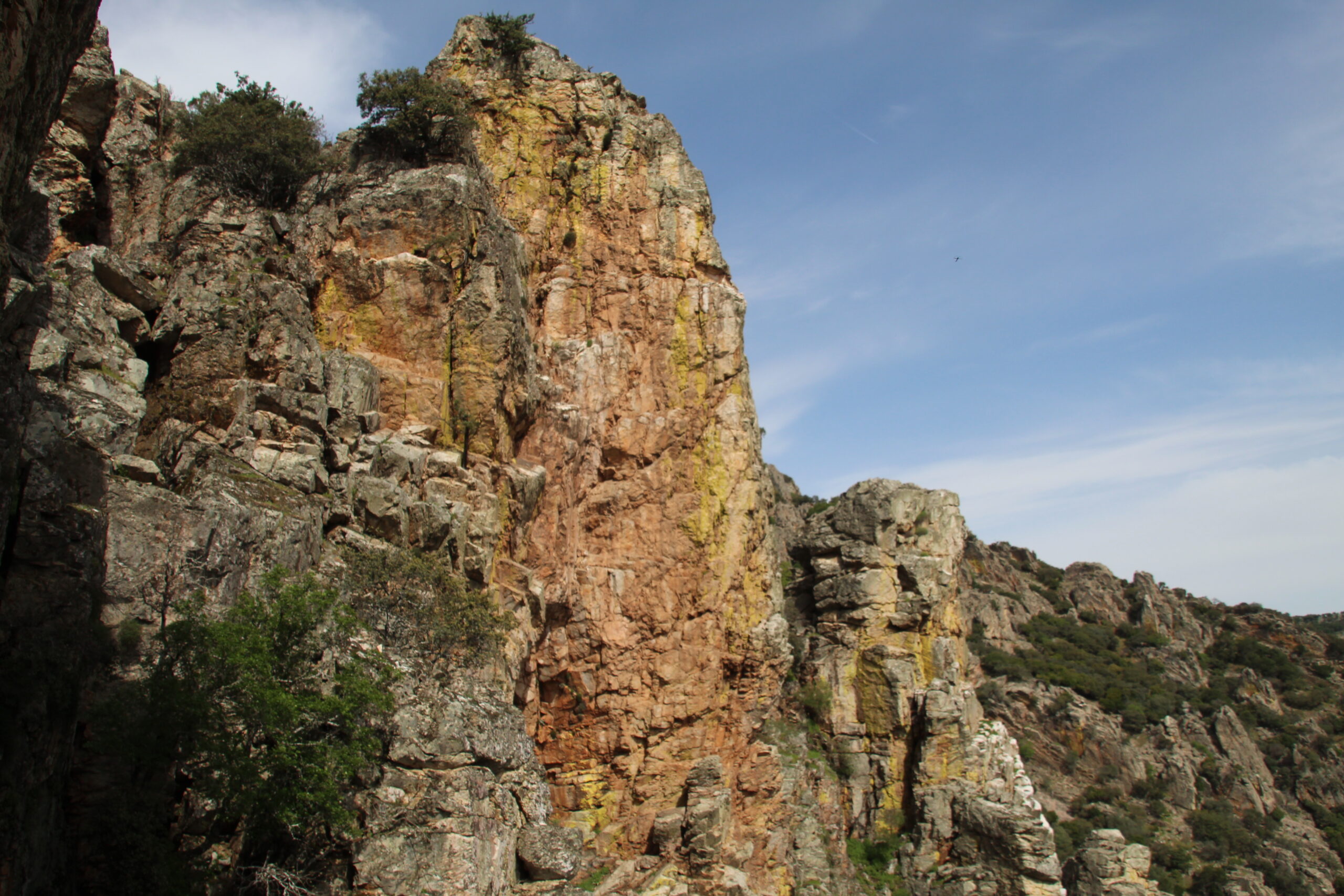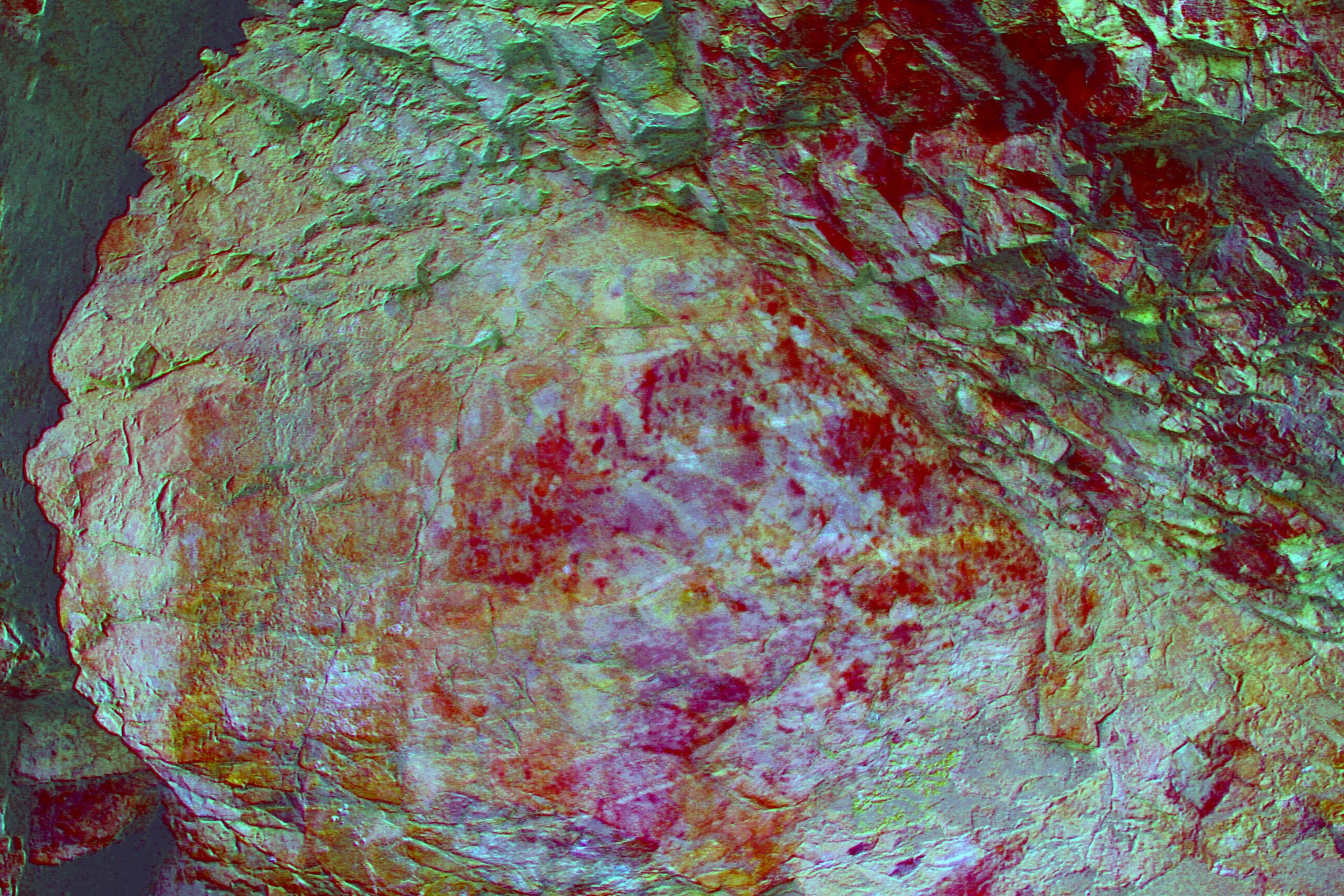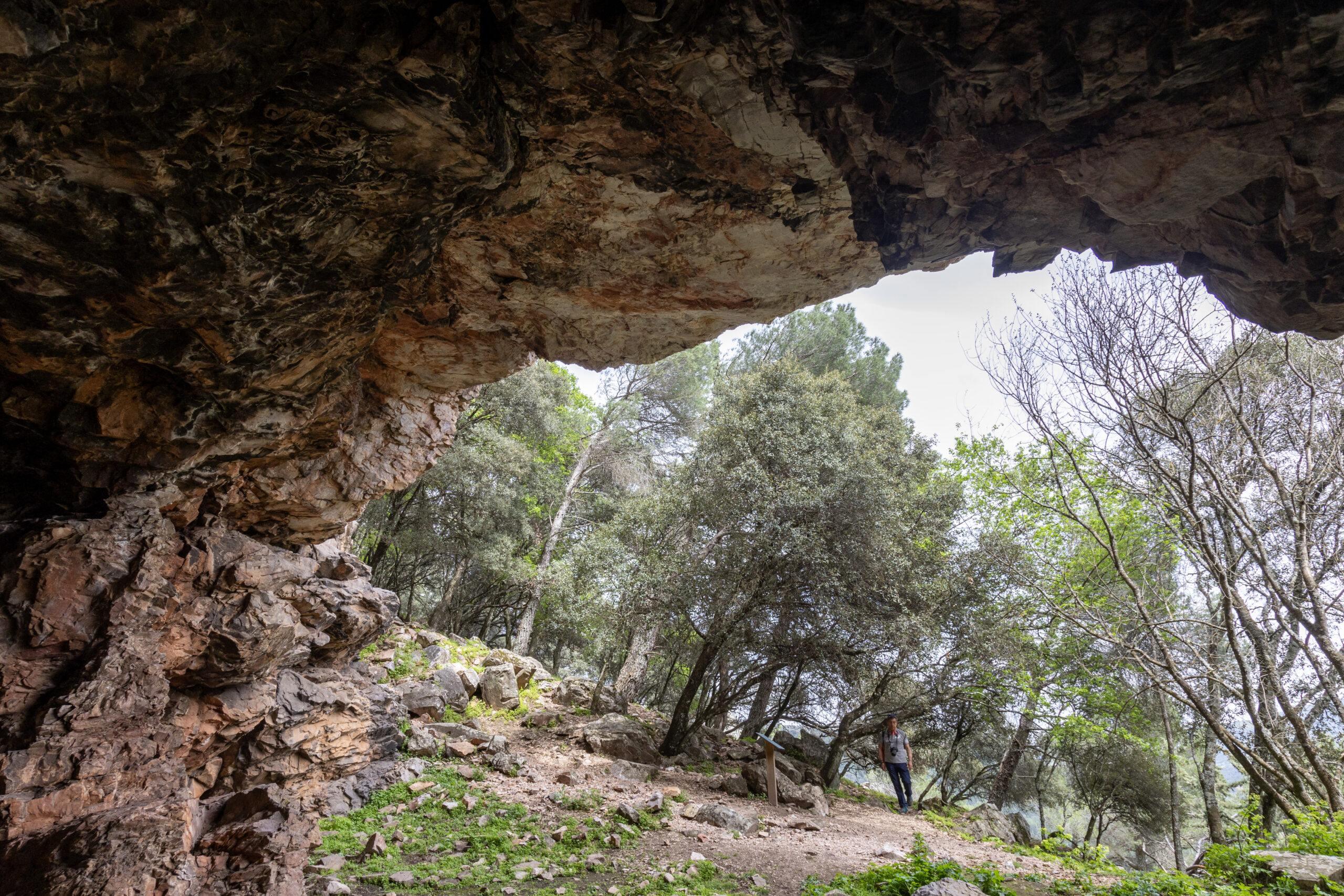Age of the artistic representations: The visit focuses on the three best-preserved panels, which have been prepared for viewing. These are three separate panels. Two are opposite the Órganos: Vacas del Retamoso I and IV, separated by about 25 meters. The third is higher up, in the rock formations: Los Órganos. The visit focuses on the three best-preserved panels, which have been prepared for visitors. These are three separate panels. Two are opposite the “Órganos”: Vacas del Retamoso I and IV, separated by about 25 meters. The third is higher up, in the rock formations: Los Órganos. Vacas del Retamoso I is the first one you see when you go up the path. It is on a rocky ledge to the northwest.
The panel shows a rectangle enclosing a ramiform, superimposed on a schematic goat with long horns, painted in a lighter tone.On either side are two stars (known as stelliforms), a lattice-shaped figure, another figure with two appendages, and several comb-shaped figures, perhaps schematic quadrupeds.
Vacas del Retamoso IV is higher up, to the right of the so-called Cueva de José María Tempranillo, on a smooth vertical rock. To the left of the cave there are also more panels, although in a poorer state of preservation.It is a large panel with numerous figures painted in dark red or lighter shades.For the purposes of description, we will divide it into four sections, from left to right.
In Sector 1, a figure in the shape of a weightlifting barbell, perhaps an animal or a person, with ears, a face, hands, and feet, stands out. Next to it is a poorly preserved anthropomorphic figure. Below are several figures in the shape of a sun, parallel vertical bars, and a comb-shaped figure.
Next, Sector 2, with a large number of paintings. At the top left, there is a group of fingerprints and many bars of different strokes: straight, zigzag, wavy, a bar with successive linked arcs, two parallel bars with dots between them, and a horizontal line with arrow-shaped ends and vertical strokes. There are also three anthropomorphic figures: two bitriangular with handle arms, one probably armed, and another in a double Y shape. Further down there are more bars, dots, spots, and other anthropomorphic figures: one with raised arms, another with short, bulging legs and X-shaped arms, and another formed by the outlines of the head, arms, and legs. Also noteworthy are a bilobed figure, a sawtooth line, a branch-shaped figure, a comb-shaped figure, and several sun figures.
Sector 3 is next. It also contains many figures, some of which are superimposed. There are many vertical bars and dots. Then there are a dozen comb-shaped figures of various sizes, a circle of dots, and two branch-shaped figures.
Finally, on the right is Sector 4, although it contains fewer figures and they are in poorer condition. There are several bars, three bitriangular human figures—two in pairs and another under an arch—a pair of circles with a central dot, and a possible idol. Following the path and ascending between the rocks on a spectacular walk with views and scenery, we will reach almost the top. There, in a small rock shelter, is Complex VII, known as “Los Órganos” or also as the panel of cats, sorcerers, or priestesses.
It is located at an altitude of 890 meters, protected by a fence and accessible only by a narrow one-meter ledge. The shelter is small, barely 6.5 meters wide, 2.5 meters high, and only 3 meters deep. The figures are very well preserved thanks to the protection of the shelter’s visor. The most famous are a pair of human figures with cat-like whiskers. Hence, they are known by this name: cat women. The body has been represented with two triangles, which has been interpreted as representations of women wearing skirts. They wear a kind of headdress in the shape of horns or feathers. Two circles have also been depicted, probably the eyes or circular earrings. On either side of the head are “whiskers,” interpreted as hairpins. The arms are arched as if dancing, and the fingers are marked with several lines.
The figure on the right has unpainted lines under the arms, as well as in the circles of the supposed earrings, which may correspond to remnants of paint in other shades that have been lost, perhaps decoration on the clothing or body paint. Next to them is a schematic deer with large antlers, its mouth open as if it were bellowing, and an erect phallus. Below is a bow with five arrows in parallel. On the right is another inverted bitriangular human figure with its feet up. Several interpretations have been proposed: women, sorcerers, or female deities. The most widely accepted theory is that they represent female goddesses linked to fertility and hunting. Their location on high ground is not unusual. There are parallels of other idols hidden in elevated places.
General description of the destination: Perched high in the mountains, sixteen shelters with rock art are preserved, in varying states of conservation. Their location in this rugged landscape indicates that this place held a powerful attraction for prehistoric communities. The artistic panels are located in fractures in the quartzite rock, where the straight, smooth walls served as a canvas.
They are artistic expressions depicting figurative, schematic, and abstract motifs. Their meaning is unknown: perhaps spiritual, social, or economic. Human figures and animals predominate in these representations, suggesting that this relationship was important to these communities.They date from the Neolithic to the Chalcolithic periods, from around 8000 or 7000 years ago to around 4000 years ago.The oldest are in the Levantine style: deer or goats with disproportionate bodies and rigid limbs.The most recent are in the schematic style, with figures reduced to the minimum number of strokes possible.The paintings are concentrated on the hillside above the mountain pass, although they are not the only ones. Nearby is the Aldeaquemada site, linked to the river environment, with the Tabla de Pochico and the Prado del Azogue as the main examples.
History of the site: Vacas del Retamoso was one of the first sites studied on the Iberian Peninsula.It was thanks to French archaeologist Henri Breuil, who catalogued it in 1913 during an expedition to Sierra Morena. He was assisted by Tomás Pareja Luna, a resident of Fuencaliente, who was responsible for exploring the area before the Frenchman’s arrival. So it was probably Pareja Luna who was the real discoverer of these paintings. In 1933, Breuil published the paintings of Despeñaperros as part of the corpus of schematic art of the Iberian Peninsula.Breuil was accompanied by Juan Cabré, a prestigious Spanish archaeologist, who years later studied the nearby site of Aldeaquemada. In 1925, Eduardo Hernández Pacheco, director of the Commission for Paleontological and Prehistoric Research at the Natural Science Museum in Madrid, returned to study the site. He was accompanied by the artist Francisco Benítez Mellado. After years of neglect, research resumed in the 1970s, thanks to Navarrete’s publication. New sites were located by local shepherds and scholars who, prompted by news of the existence of these paintings, reported new sites. Among them is the panel of “Las sacerdotisas” (The Priestesses) (Los Órganos), found by Miguel Molina Pérez, nicknamed “El Magañés.” Others were discovered by Carlos Sánchez-Batalla, and later by Ramón Viñas, Elisa Sarriá, and Ángel Alcaide.
Museographic resources description: In Vacas del Retamoso is the Cave of José María Tempranillo. Legend has it that the bandit and his gang took refuge there during the War of Independence against the French. A few meters to the right is another cave with the same tradition. In 2021, the paintings of Los Órganos were damaged with red spray paint by some unscrupulous individuals. A restoration team managed to remove them completely.

